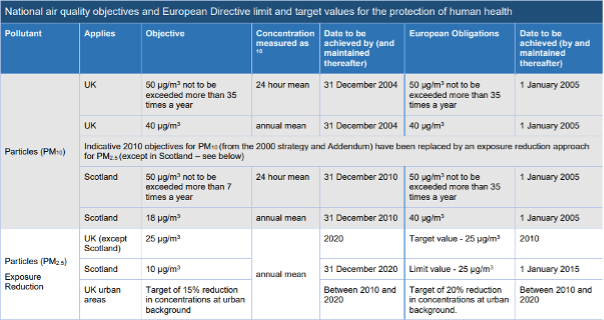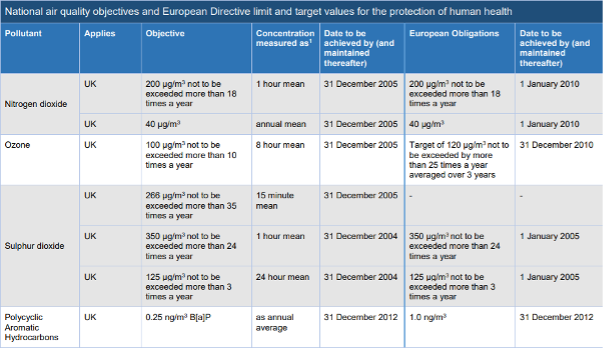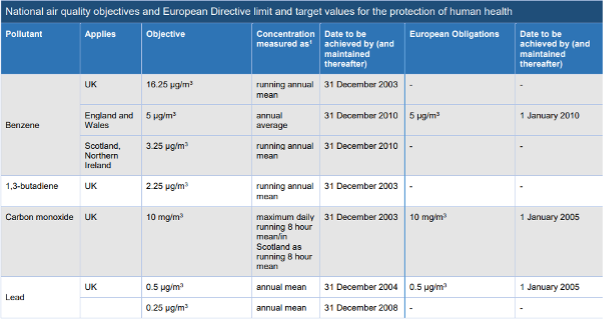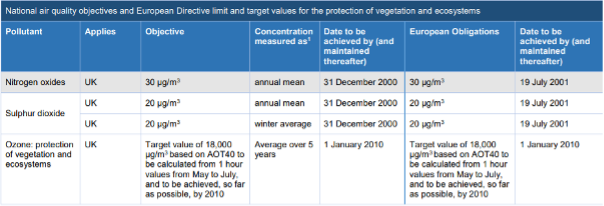Legislation, policy, standards and objectives
Air Quality Strategy
The Air Quality Strategy for England, Scotland, Wales and Northern Ireland (latest version published in July 2007) establishes the framework for air quality improvements across the UK. Measures agreed at the national and international level are the foundations on which the strategy is based. The strategy sets out the UK Air Quality Standards and Objectives which have been set in order to measure the improvement of air quality and are discussed below.
Clean Air Strategy
In January 2019, the UK Department for Environment, Food and Affairs published the UK Clean Air Strategy. This strategy seeks to achieve the following stated goals:
- Protect the nation’s health
- Protect the environment
- Secure clean growth and innovation
- Reduce emissions from transport, homes, farming and industry
- Monitor progress
UK and EU Air Quality Limits
There are a wide range of terms and concepts in national and international initiatives, for example, standards, objectives, target values and limit values. The two which feature within the UK’s air quality strategy are standards and objectives. The EU Ambient Air Quality Directive and fourth Daughter Directive contain Limit Values and Target Values. The national Air Quality Objectives and EU limit and target values with which the UK must comply are summarised in the National air quality objectives of the Air Quality Strategy and are presented in the tables below.
Definitions:
- Air Quality Standards are concentrations recorded over a given time period, which are considered to be acceptable in terms of what is scientifically known about the effects of each pollutant on health and on the environment. They can also be used as a benchmark to indicate whether air pollution is getting better or worse.
- An exceedance is a period of time (defined for each standard) where the concentration is higher than that set out in the Standard. In order to make useful comparisons between pollutants, (the Standards may be expressed in terms of different averaging times), the number of days on which an exceedance has been recorded is often reported.
- An objective is the target date on which exceedances of a Standard must not exceed a specified number.
- EU Limit values are legally binding EU parameters that must not be exceeded. Limit values are set for individual pollutants and are made up of a concentration value, an averaging time over which it is to be measured, the number of exceedances allowed per year, if any, and a date by which it must be achieved. Some pollutants have more than one limit value covering different endpoints or averaging times.
- Target values – are used in some EU Directives and are set out in the same way as limit values. They are to be attained where possible by taking all necessary measures not entailing disproportionate costs.
Local Air Quality Management
A system of Local Air Quality Management (LAQM) has been in place in the UK since 1997, with the overall aim of ensuring that the national air quality objectives will be achieved in all areas. Defra and the Devolved Administrations have issued Technical and Policy Guidance documents for LAQM, to ensure that all local authorities (district councils in Northern Ireland) follow best practice.
District councils are required to review their current air quality and assess whether any locations are likely to exceed the Air Quality Strategy Objectives. If they identify areas of exceedance then one or more Air Quality Management Areas (AQMAs) will need to be defined, and appropriate Action Plans developed and implemented. District councils are encouraged to work together, and to consult with other local stakeholders to ensure that the process is carried out in a transparent fashion. Kent and Medway local councils work together in an Air Quality Group and form the Kent and Medway Air Quality Network.
Information on LAQM in Kent and Medway, including details of AQMAs and Action Plans, is available from the LAQM and Reports sections of this website.
Further Information
For further information on air quality policy within Kent, Medway, the UK and European Community, please see the UKAIR pages, Defra policy webpage and the Kent County Council Page.



